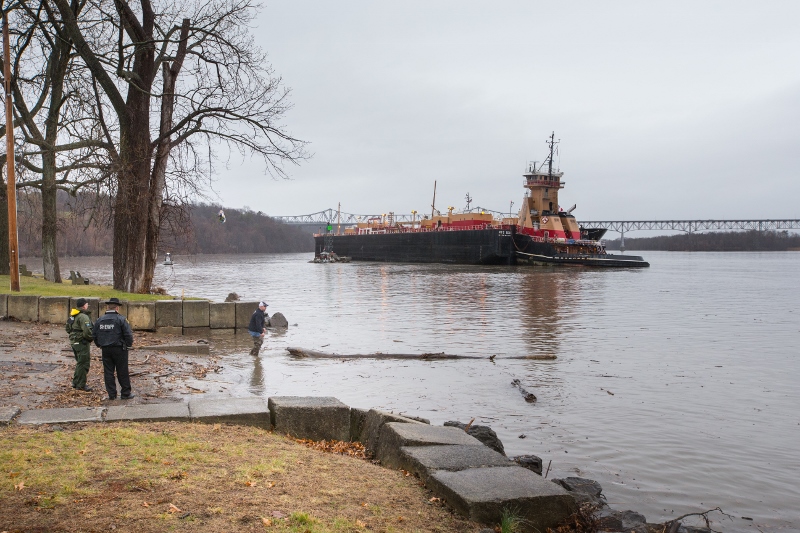
New York Governor Andrew Cuomo at the site of the Hudson River grounding on Tuesday, April 4.
An articulated tug-barge carrying 60,000 bbl. of gasoline up the Hudson River got safely off Tuesday night after running aground about 30 miles south of Albany, N.Y.
There was no spill from the double hull barge RTC 150, and a rising tide lifted the 458’x72’ barge and its tug, the 119’x40’x22’, 7,200-hp Meredith C. Reinauer. The ATB continued to Albany where it unloaded its cargo.
But the incident is certain to play into debate over a proposal for up to 10 designated barge anchorages along the river, under consideration by the Coast Guard and opposed by environmental groups and town governments along the river.
“The Hudson River is a critical piece of the Empire State, both environmentally and economically, and we are launching a full-scale response to ensure this incident does not threaten it,” said Gov. Andrew Cuomo, who visited the scene just south of the Rip Van Winkle Bridge at the village of Catskill.
“The full resources of several state agencies including the Departments of Environmental Conservation and Health have been deployed to not only ensure a quick and thorough response, but to launch a full investigation into what caused the barge to run aground in the first place.”
The Albany-bound ATB grounded at a stone marker on the western edge of the channel around 8:30 a.m. Tuesday, and marine investigators from Coast Guard Sector New York are examining how the mishap occurred. Early on during the incident, a crew from the Coast Guard Aids to Navigation Team-Saugerties responded, and reported there was no sign on leakage from the double hull vessel.
The Reinauer Transportation Co. dispatched the 114’x40’x17’, 4,000-hp tug Craig Eric Reinauer with the 413’x74’ barge RTC 103 to stand by.
The Coast Guard and state Department of Environmental Conservation monitored the operation from shore and in small boats. After refloating and a visual inspection by the Coast Guard, the Meredith C. Reinauer proceeded to Albany, arriving around 7 a.m. Wednesday, escorted by a New York State Marine Highway Transportation tug, the 90’x29’x12’, 2,400-hp Mary Kay, Coast Guard officials said.
While investigations continued, critics of the anchorage plan cited the incident. The New York marine transportation industry requested the Coast Guard to consider the plan, citing increasing traffic on the Hudson and need for safe anchorage spaces.
In October 2015 the Coast Guard advised operators they could only anchor in the seven federally designated anchorages now charted. That alarmed operators, who said they had been able to informally anchor for years, and need space on the upper river.
“As custom and practice, the tug and barge Industry has been anchoring outside of federally designated anchorage grounds in the Hudson River for decades,” the Maritime Association of the Port of NY/NJ tug and barge committee wrote in a January 2016 letter to the Coast Guard.
Of the existing federally designated anchorages, “only one is within the 109 nautical miles from Yonkers, New York, to the Port of Albany. The capacity and availability of these anchorages is woefully inadequate to support marine trade,” the group wrote.
Local officials and community groups that see the riverfront as a recreational asset and boost to property values are fighting the plan. So too are environmental groups, who are trying to block new pipeline and barge routes for bringing shale oil from the western states to East Coast refineries.
The grounding “plainly demonstrates the danger of the Coast Guard's ill-conceived anchorage proposal,” said state Sen. Terrence Murphy, a Republican who represents river towns and helped organize opposition to the anchorage plans.
“There is already a firm legal basis which shows the rule is inconsistent with other federal laws and must be withdrawn,” Murphy said in a statement. “Situations such as this are uncommon, but today proves once again that the Hudson River should not be converted into an industrialized parking lot for fuel barges.”

Additional Reinauer vessels stand by as part of the recovery operation for the Meredith C. Reinauer. Philip Kamrass/ Office of Governor Andrew M. Cuomo photo.





